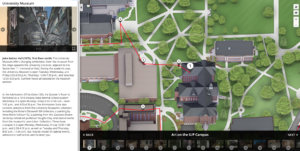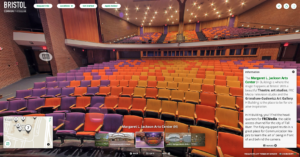Building an engaging presence for your university’s arts program takes time and effort. The right resources and opportunities, though, can make all the difference. Consider these four ways in which your virtual college tour and interactive campus map help to highlight your visual and performing arts events and accomplishments to potential students and the larger community.
1. Label your arts locations with a campus map
Let’s start with the basics. Visual and performing arts programs, perhaps more than any other discipline on campus, have a physical footprint. Students may showcase their work in local galleries or even in hallways across campus, while performing in amphitheaters and auditoriums.
Your audiences, meanwhile, will need to know about these physical locations for two reasons:
- Prospective students in graphic design, studio art, theater, dance, and any other arts-related discipline want to know exactly how they will be able to display their work, which is usually a core part of their curriculum.
- Members of the local community may simply be looking for weekend or evening activities. An easy way to find theater performances and art galleries might be just the thing they need.
Your interactive campus map, when organized correctly, can solve needs for both of these audiences. For example, you can easily create a category for Arts and Performance, like Indiana University has, allowing you to group all related buildings together and add important links.
Of course, you can also get more in-depth. Consider, for instance, creating a walking tour that takes visitors through all the spaces on campus in which current students display their arts projects. Indiana University also does this extraordinarily well. The department, and the university at large, can now promote that walking tour to both students and locals to increase arts engagement in the area.
2. Provide a 360-degree virtual tour of arts halls and galleries
A virtual tour is an immersive opportunity for students to imagine themselves at your university. So why not leverage that platform with a stop designed specifically for your arts program?
Bristol Community College in Massachusetts, for instance, created a stop for its Margaret L. Jackson Arts Center in the college’s virtual tour. Virtual visitors can view the impressive theater and imagine themselves performing there thanks to the immersive 360-degree image. This is important especially as community colleges are continually on the receiving end of negative stereotypes. A virtual tour stop like the one above forces students to move past any potential biases and appreciate the school for the amazing opportunities it offers.
But the benefits of this addition to their virtual tour don’t end there. Bristol Community College also integrates supplemental media into the tour stop, including:
- Textual information and images about other creative activities in the same building, including an art gallery and a television studio.
- Background information about theater at the college, including an embedded video describing the program.
Another school who uses their virtual tour to showcase their art galleries is Purchase College in New York. Their Neuberger Museum of Art tour stop seamlessly displays their modern art gallery.
What else can you find in Purchase’s tour stop?
- Historical background of the art gallery, including whose art is included in the museum.
- Internships and academic opportunities for students interested in pursuing a career in art.
For many potential communication, art, and theater students, these stops are an in-depth look into the buildings they’ll learn to call home, providing them with both fact-based information and emotional resonance that comes close to a physical visit.
3. Integrate solutions with your existing digital media
Virtual tours and interactive campus maps don’t exist in isolation. At their best, they’re part of a larger digital ecosystem. Whether you’re trying to reach your prospects, the local community, or both, multiple touchpoints can get your audience’s attention and drive your intended message home.
Integrating both of the pieces above with your existing digital communications efforts, then, becomes a crucial piece of your marketing strategy. That can happen in a wide range of ways. For example, you can:
- Create email campaigns to students interested in the arts, in which you link directly to the arts-focused virtual tour stop.
- Include a link to your interactive map’s arts and performance category each time you confirm a prospect’s visit.
- Encourage your current art students to use your tour stop or interactive map link when they talk about their college experience on social media.
- Link to your interactive map each time you promote a student performance, gallery exhibit opening, or similar events in the local community.
- Partner with local organizations to include links to your performing and visual arts presence in their publication and on their website.
Of course, these are just some of the countless opportunities to integrate your map and tour arts showcase with larger digital campaigns. At the same time, you can also use other assets gathered for other channels in the map and tour itself.
This is again where Bristol Community College’s integrated theater video comes into the picture. Photos and videos from arts classes and student performances can live in both your map and your tour. You can even include the showtimes and current exhibits of your productions and galleries in the information section of your interactive map.
4. Connect to local and regional opportunities in the arts
Finally, one central benefit of interactive campus maps is that they don’t have to stop at your campus borders. Many universities use them to also highlight their campus surroundings, like bus routes or local restaurants.
Many colleges, for instance, allow and encourage their students to showcase their art projects not just on campus, but in local exhibit spaces. Theater students might perform not just in student-run productions, but with local performance groups.
Through your campus map, you can both highlight these external opportunities and guide your campus community to them. A local exhibit with art from your own students will get more attention if its location appears on your university’s map, where you can link directly to anything from directions to additional information about the program.
Expanding your arts program’s digital footprint beyond campus borders also comes with a few additional advantages. First, it fosters goodwill in your community, preventing any negative town and gown relations between local residents and college students. Second, it enables you to highlight the real-world experiences students in your arts program can receive even without having to travel to another town.
Enhance the digital presence of your arts program with Concept3D
A university’s arts programs rely on their physical footprint to “sell” students on their benefits. Meanwhile, they also tend to be the most visible to the local community, creating added value for the university by providing both foot traffic and entertainment possibilities for local residents.
That’s why creating a comprehensive digital presence that represents and enhances the art department’s physical footprint is such an important endeavor. Tools like interactive campus maps and virtual college tours can go a long way towards engaging audiences, providing a valuable complement to the in-person performances, recitals, and art displays.
That’s where Concept3D enters the equation.
Our extensive experience in higher education makes us a perfect partner. We’ve worked with many colleges who have successfully used our tools to showcase their art departments and programs to their core audiences.
Ready to learn more, or see more examples of some of the above concepts in action? Contact us today to get started.




